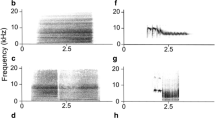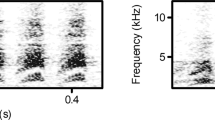Summary
The song and the anxiety churring of the Indian Great Tit(Parus major mahrattarum) were played back to the European Great Tit(P. m. major) near Budapest and the song and the anxiety churring of the European Great Tit were played back to the Indian Great Tit in the Thekkady National Park, South India. The anxiety churrings of the two subspecies were similar, their songs were conspicuously different. The European subspecies responded significantly more to the sounds of the Indian subspecies than did the Indian to the sounds of the European subspecies. This phenomenon can be explained by the higher acoustic responsiveness of the European Great Tit. The increased acoustic responsiveness together with the increased social tendency could have promoted the adaptability of the European Great Tit.
Zusammenfassung
Der Gesang und der Alarmruf der indischen Kohlmeise wurde europäischen Kohlmeisen in der Umgebung von Budapest vorgespielt und umgekehrt der Gesang und der Alarmruf der europäischen den indischen Kohlmeisen im Nationalpark Thekkady (Kerala). Der Alarmruf beider Unterarten ist ähnlich, der Gesang jedoch verschieden. Die europäische Unterart reagierte signifikant öfter auf den Gesang und den Alarmruf der indischen Unterart als die indische Unterart auf die Lautäußerungen der europäischen. Diese Erscheinung ist mit der größeren akustischen Reaktionsfähigkeit der europäischen Kohlmeise zu erklären. Eine ausgeprägtere akustische Sensibilität weist auf eine stärkere soziale Tendenz hin und diese führte möglicherweise zu größerer Anpassungsfähigkeit der europäischen Kohlmeise.
Similar content being viewed by others
Literature
Emlen, S. T. (1972): An experimental analysis of the parameters of bird song eliciting species recognition. Behaviour 41: 130–171.
Frings, H., & (1958): Reactions of American and French species ofCorvus andLarus to recorded communication signals tested reciprocally. Ecology 39: 126–131.
Gompertz, T. (1968): Results of bringing individuals of two geographically isolated forms ofParus major into contact. Vogelwelt Beih. 1: 63–92.
Harris, M. A., &P. E. Lemon (1972): Songs of Song Sparrows(Melospiza melodia): individual variation and dialects. Can. J. Zool. 50: 301–309.
Löhrl, H., &G. Thielcke, (1969): Zur Brutbiologie, Ökologie und Systematik einiger Waldvögel Afghanistans. Bonn. zool. Beitr. 20: 85–98.
Marler, P., &M. Tamura (1962): Song “dialects” in three populations of White-Crowned Sparrows. Condor 64: 368–377.
Milligan, M. M., &J. Verner (1971): Interpopulational song dialect discrimination in the White-Crowned Sparrow. Condor 73: 208–213.
Nottebohm, F., &R. K. Selander (1972): Vocal dialects and gene frequencies in the chingolo sparrow(Zonotrichia capensis). Condor 74: 137–143.
Stein, R. C. (1963): Isolating mechanisms between populations of Traill's Flycatchers. Proc. Amer. Philos. Soc. 107: 21–50.
Thielcke, G. (1969): Die Reaktion von Tannen- und Kohlmeise(Parus ater, P. major) auf den Gesang nahverwandter Formen. J. Orn. 110: 148–157.
Thompson, W. L. (1970): Song variation in a population of Indigo Buntings. Auk 87, 58–71.
Thönen, W. (1962): Stimmgeographische, ökologische und verbreitungs-geschichtliche Studien über die Mönchsmeise(Parus montanus Conrad). Orn. Beob. 59: 101–172.
Author information
Authors and Affiliations
Rights and permissions
About this article
Cite this article
Sasvári, L. Different responsiveness of Indian and European Great Tit(Parus major mahrattarum; P. m. major) to acoustic stimuli. J Ornithol 121, 391–396 (1980). https://doi.org/10.1007/BF01643334
Published:
Issue Date:
DOI: https://doi.org/10.1007/BF01643334




